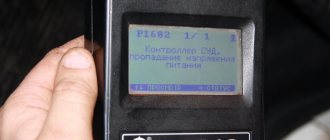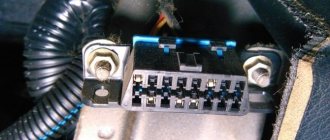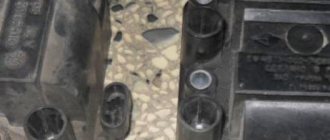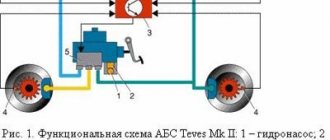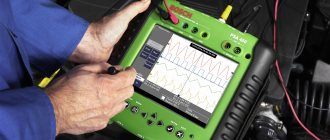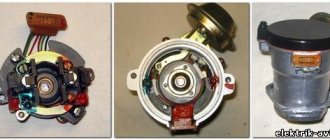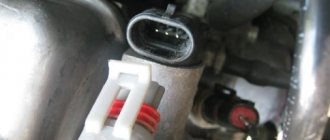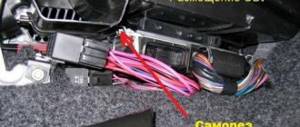Errors p0351, p0352, p0353, p0354 are associated with faults in the ignition system. In particular, ignition coils (coils), wiring or control unit. Problems with the coil are usually caused by shorted turns on the primary or secondary winding or its breakdown. As for the wiring, this can be either a break in individual wires, damage to their insulation, or, as a consequence, a short circuit between them or to ground (housing). The most difficult case is the breakdown of the electronic control unit, in particular, the breaking off of part of the ceramic board with connectors, which is diagnosed by the electronics precisely as errors with numbers p0351, p0352, p0353 and p0354.
What does the error code mean?
Most automobile gasoline injection engines use an ignition system with individual coils. This means that each of its cylinders has its own coil, to the secondary winding of which a spark plug is connected, which supplies a spark to ignite the air-fuel mixture. Error codes p0351, p0352, p0353 and p0354 mean that there is a malfunction in the primary or secondary winding of the ignition coil of cylinder A, B, C, D (Ignition Coil A Primary/Secondary Circuit Malfunction). The last number and the letter itself indicate which coil is not working. Their signs and causes are identical, so we will consider them comprehensively.
However, all four errors will appear, for example, in a 16-valve engine, where each coil is provided separately for each cylinder. If the engine is 8-valve (for example, VAZ), then on such power units the design provides only one so-called ignition module, where only two coils are mounted. Therefore, errors will only occur with codes p0351 and p0352. Conversely, on powerful engines (for example, SUVs or sports cars), if they have six, eight or more cylinders, the number of errors may also increase (up to p0362, that is, a 12-cylinder engine).
The engine electronic control unit (ECU) determines the ignition angle for each cylinder separately, which allows a spark to be supplied at a strictly defined, suitable moment in time. This occurs by applying a signal to a power transistor in the ignition amplifier. The transistor, in turn, passes or blocks current to the primary winding of the coil. The ignition amplifier also provides feedback, when a corresponding signal is sent to the computer in the event of successful voltage transfer. If a malfunction is detected in circuit A, B, C, D of electronic ignition control by the ECM controller, then the corresponding malfunction code is set: P0351, P0352, P0353, P0354.
Code generation condition
Information about the formation of OBD errors p0351, p0352, p0353, p0354 is recorded in the memory of the electronic control unit when a number of the following conditions are met:
- The car engine ignition is turned on;
- the feedback signal informs the electronic control unit that the device has not worked;
- the number of failures of individual ignition coils is constantly growing;
- a corresponding error in the ECU memory will be generated when the number of failures reaches 20 in 40 test cycles.
The information provided is relevant for the popular Chevrolet Lacetti car, however, the logic for generating errors in most cars will be similar.
Conditions for clearing code from ECU memory
Errors p0351, p0352, p0353, p0354 are deleted from memory if one of the conditions is met:
- four consecutive ignition cycles have passed during which no malfunctions in the operation of the ignition coil were detected;
- the power supply to the ECM was turned off for more than 10 seconds;
- The diagnostic code must be cleared with a scan tool.
The archive of diagnostic error codes itself disappears from the ECU memory after 40 consecutive heating cycles, provided there are no faults.
Errors p0363 and p1304
You can detect these errors if you use a self-diagnostic adapter. Each of them has its own decoding and provides the car owner with certain information about the breakdown that occurred in the car. So, the number 0363 (error code) on 2114 indicates that misfire occurred in one of the engine cylinders and the supply of the fuel mixture to it was stopped.
In most modern cars, an electronic control system automatically stops the flow of fuel to the cylinder if any problems occur in it.
The next error - 1301...1304 indicates that in a specific cylinder (the number of which is equal to the last digit in the error number) there were ignition delays, which are critical for the converter.
Often these errors are accompanied by errors of type 0300 - exceeding the threshold of danger (toxicity) of the exhaust as a result of misfire.
Signs of breakdown
External signs of error codes p0351, p0352, p0353, p0354 include:
- activation of the Check Engine warning light on the dashboard;
- misfires in one or more engine cylinders (depending on the number of errors), this leads to the engine “troubling”, operating unstably, and having an uneven idle;
- drop in engine power and deterioration in the dynamic characteristics of the machine;
- problems starting the engine.
Since such signs may indicate other problems with the engine, reading diagnostic codes with an error scanner is mandatory, this will allow you to move on to further specific checks.
Description and meaning of error P0030
This diagnostic trouble code (DTC) is a generic powertrain code, which means it applies to OBD-II equipped vehicles, including but not limited to Toyota, VW, Ford, Dodge, Honda, Chevrolet, Hyundai, Audi, Acura, etc. Specific repair steps may vary depending on the model. In order for the engine to work correctly, there must be a very specific air: a fuel ratio of 14.7:1. To accomplish this, the ECM (engine control module) relies on heated oxygen sensors (HO2S). HO2S detects the oxygen content in the exhaust. This information is then transmitted to the ECM. The ECM uses this information to adjust the fuel supplied to the engine. The Heated Oxygen Sensor contains a circuit dedicated to operating a heater that heats up the Oxygen Sensor faster than the exhaust gases could. This reduces the time it takes for the engine to achieve a closed cycle, which reduces emissions. On some vehicles, the O2 sensor heater is supplied at 12V, fused to the voltage supply and computer-controlled ground. A 12V voltage supply is supplied to the heater at any time when the key is in on position. The computer activates the heater under certain circumstances by connecting the ground to the oxygen sensor heater. On other ships the O2 sensor heater may be supplied with a computer-controlled 12 volt power supply and continuous ground. If the ECM detects a fault on bank 1, P0030 sensor 1 heater circuit may set.
Causes of malfunction
There are five main malfunctions that cause OBD errors p0351, p0352, p0353, p0354 to be generated in the memory of the electronic control unit. Among them:
- Faulty spark plugs or their wires. Spark plugs can fail either partially (for example, due to contamination of the electrodes) or completely, as a result of which a spark will not appear on the electrodes at all.
- Ignition coil malfunction. Typically this failure is caused by the primary and/or secondary windings being shorted. Moreover, this can be either an interturn short circuit or a short circuit between the primary and secondary windings. In the first case, usually the voltage generated is not enough to ignite the air-fuel mixture, and in the second, there will be no voltage at all. Often, when a short circuit occurs, the corresponding fuses blow. Another option is a partial failure of the rubber tip of the coil, which causes a spark to simply break through to the body.
- Wiring problems. In this case, there may be breaks: between the control unit and the coil, between the coil and the spark plug, or the supply wiring. In this case, this can be either a complete break in the wires or damage to the insulation section/sections. For example, when rubbing in places of bending, exposure to extreme temperatures, and so on. In any case, diagnostics must be performed using an electronic multimeter, which allows you to find the corresponding damage.
- Control unit malfunction. This is the worst case. As mentioned above, inside the block there is a ceramic plate on which power and signal electrical contacts are installed (the design of the control unit may differ for individual car models). Due to constant overheating, the plate becomes fragile, and sometimes a situation arises when a piece of the plate with contacts simply falls off from its main part.
Another, but rather rare reason why the indicated errors with code p0351, p0352, p0353, p0354 are formed in the ECU memory are the so-called “glitches” of the control unit. In particular, its bugs in its software. This can happen, for example, after reflashing the unit, or after mechanical damage (for example, as a result of an accident).
Diagnosis of errors p0351, p0352, p0353, p0354
If the scanner detects one or more of the above ignition coil or module error codes, further verification must be performed as follows:
- Programmatically delete error information from the electronic unit’s memory. This must be done in order to prevent accidental formation of errors in the block. If, after rebooting the ECU, errors are generated again, further comprehensive diagnostics must be continued.
- Next, you need to check the ignition coil indicated by the error code. This applies to both primary (primary if a common primary winding is used) and secondary windings. To do this, you need to disconnect them from the wiring and check the integrity of the winding using an electronic multimeter. It also makes sense to check the mechanical integrity of the corresponding coils, the presence of damage, contamination, and integrity of contacts.
- Check the integrity of the wires. To do this, it is advisable to get a diagram of the car's electrical contacts. This will make it easier to find out whether individual wires are broken and whether they are shorted to each other or to ground. For the corresponding check, an electronic multimeter is used, switched to the “continuity” mode. In particular, it is necessary to check the integrity of the wires between the ignition coil and the computer. To do this, the wires are disconnected at both ends for “dialing”.
- Checking the electronic control unit. First of all, you need to check whether the contacts on the ceramic plate discussed above have broken off. If everything is in order with the contacts, then you need to check the logic of the ECU. However, it is better not to check it yourself, since this is a responsible undertaking, and it is better to delegate it to specialists from a car service center, preferably an official one.
- Check for good ground contact at the ignition coil/coils. It also makes sense to check for corrosion and oxides at the contact points.
- Check the intake manifold for vacuum leaks. If such a leak occurs, ignition of the air-fuel mixture will become impossible in some cylinders, which will lead to misfire.
How to fix the problem?
Possible efforts to eliminate errors code 0351, 0352, 0353, 0354:
- replacing spark plugs and/or their wires connecting them to the ignition coils;
- replacing the ignition coil/coils, since repair of this unit is hardly possible in most cases;
- replacement or repair of power and/or signal wires on coils, electronic control unit, spark plugs (replacement is more preferable, since electric current with significant voltage passes through power wires);
- replacing or reflashing the software of the electronic control unit; in rare cases, repairs are possible, but it is better to entrust it to professionals.
Some car enthusiasts, when an ignition coil fails, do not buy it entirely (especially if they have to replace the original one with an inexpensive Chinese one), but instead order a new tip (if the design of the coil allows such a replacement). The fact is that the tip may become unusable over time due to natural reasons. When replacing, be sure to use high-temperature Teflon grease (specially designed for installing ignition coil tips) so that the new tip does not remain in the well on the spark plug.
Please note that to perform diagnostics and repairs, it is often necessary to have professional repair equipment, such as an oscilloscope and a professional scanner for the operation of individual engine components. And you need to “ring” the wires by first disconnecting the negative terminal from the battery.
The listed faults are not critical, but it is still advisable to get rid of them as soon as possible. This is due to the fact that since the corresponding errors cause the ignition system to operate incorrectly, there is a significant load on the coils, spark plugs and wires, and this leads to increased wear and tear and a decrease in the overall service life.
How to resolve P0352?
Is the engine currently not running? If not, the problem is probably intermittent. Try wiggling around while checking the wiring at coil #2 and along the harness to the PCM. If manipulating the wiring causes the surface to misfire, correct the wiring problem. Check for a loose connection at the coil connector. Make sure the tourniquet does not transfer or rub on anything. Repair the engine if necessary, stop the engine and disconnect the #2 coil wiring connector. Then start the engine and check the driver signal to coil #2. Using an area will give you a visual template to follow, but since most people don't have access to one, there's an easier way. Use a voltmeter on the AC Hertz scale and see if the Hz reading is between 5 and 20 or so, that indicates that the driver is working. If there is a Hertz signal, replace ignition coil #2. Most likely this is bad. If you do not detect any frequency signal from the PCM on the ignition coil driver circuit indicating that the PCM is grounding/unloading the circuit (or there is no visible pattern on the area if you have one), then leave the coil disconnected and check the DC voltage at driver circuits at the ignition coil connector. If there is any significant voltage on this wire, then there is a short somewhere. Find the short one and repair it. If there is no voltage on the driver circuit, turn off the ignition. Disconnect the PCM connector and check the driver continuity between the PCM and the coil. If there is no continuity repair open or short to ground in the circuit. If continuity is present, then check for resistance between Ground and the ignition coil connector. There must be endless resistance. If not, repair the short ground in the coil driver circuit. Note: if the ignition coil driver signal wire is not open or shorted to voltage or ground and no start signal to the coil then suspect a faulty PCM coil driver. Also keep in mind that if the PCM driver is faulty, there may be a wiring issue that caused the PCM to fail. It is a good idea to do the above check after replacing the PCM to check there will not be a repeat failure. If you find that the engine is not running properly, the coil is firing properly, but P0352 keeps resetting, there is a possibility that the PCM coil monitoring system may be faulty.
